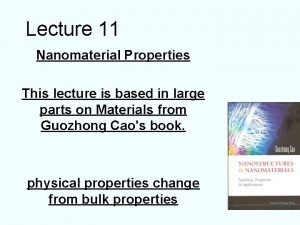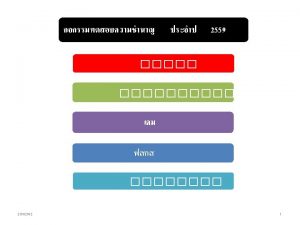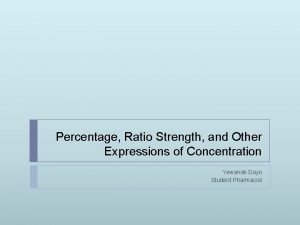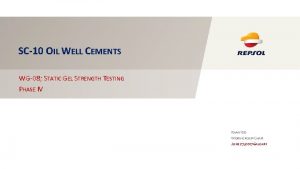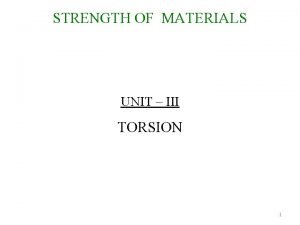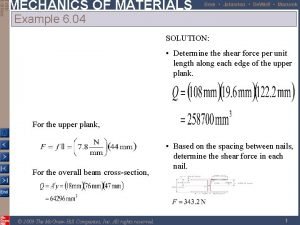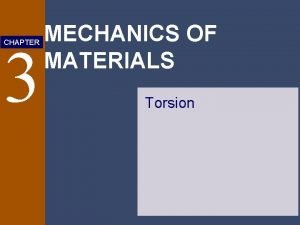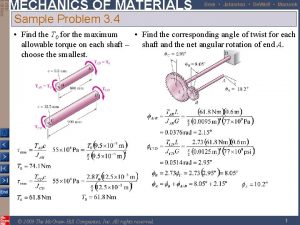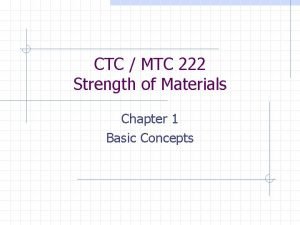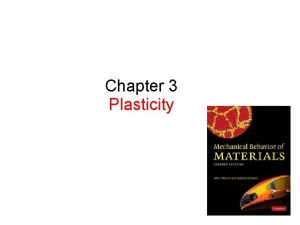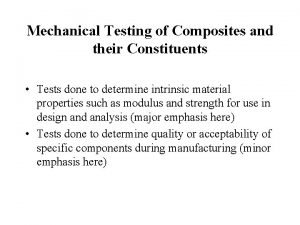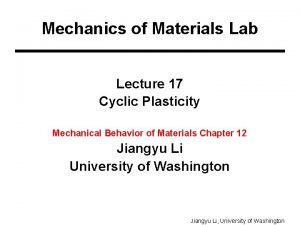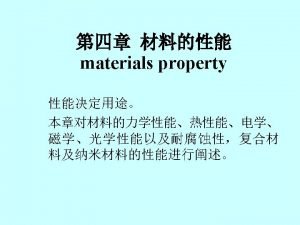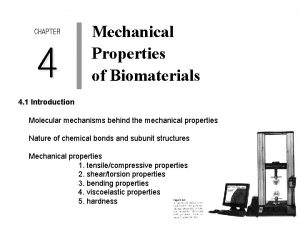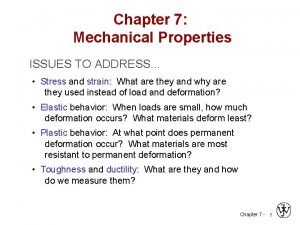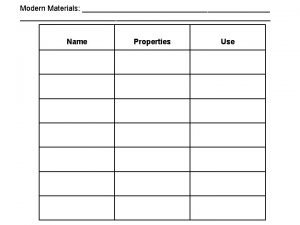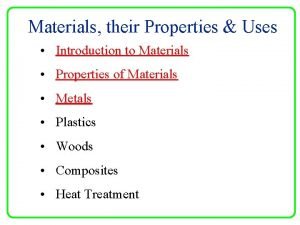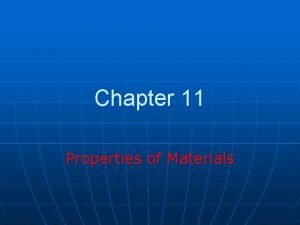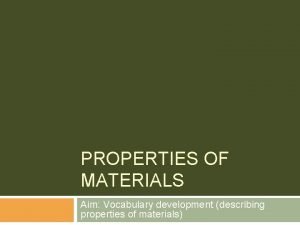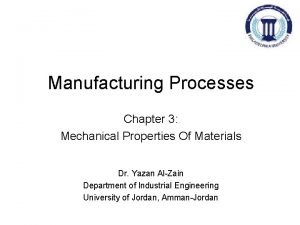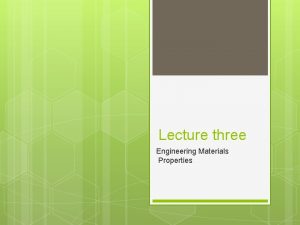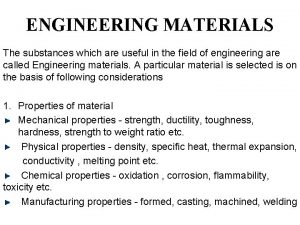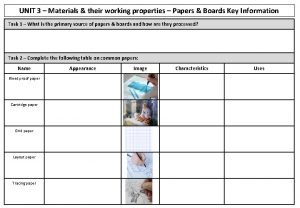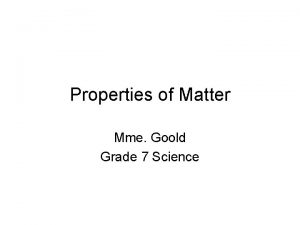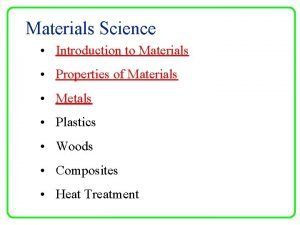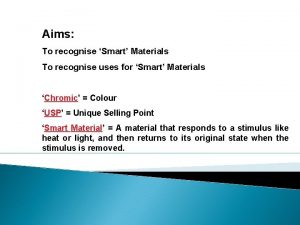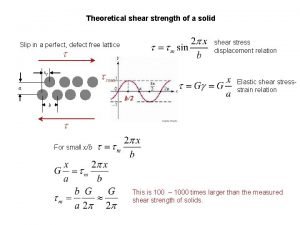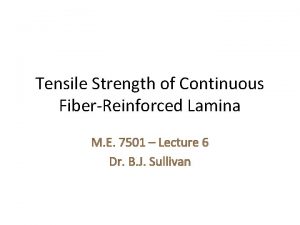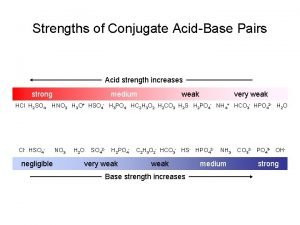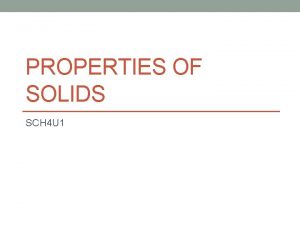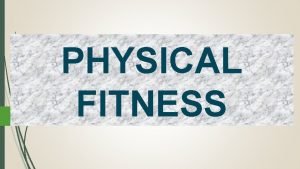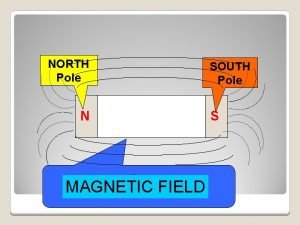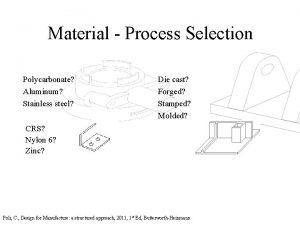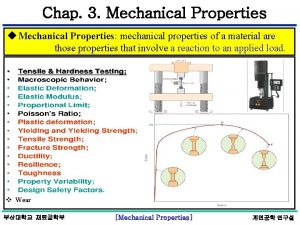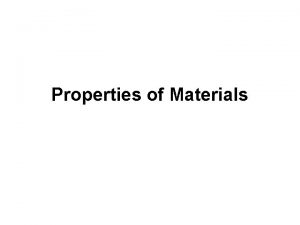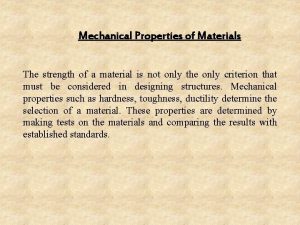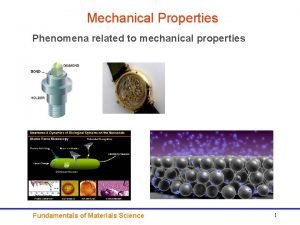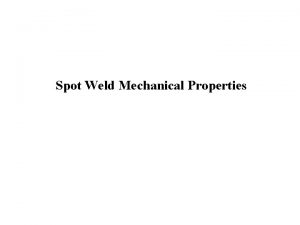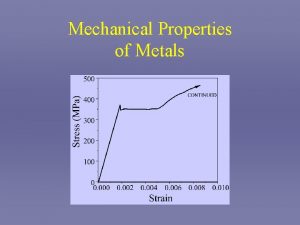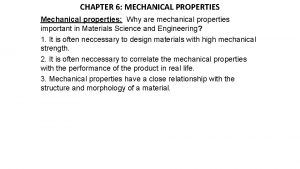SKTN 2123 Strength of Materials Mechanical Properties of




































































































- Slides: 100

SKTN 2123 Strength of Materials Mechanical Properties of Materials Mohsin Mohd Sies Nuclear Engineering, School of Chemical and Energy Engineering, Universiti Teknologi Malaysia

CHAPTER OBJECTIVES • Show relationship of stress and strain using experimental methods to determine stressstrain diagram of a specific material • Discuss the behavior described in the diagram for commonly used engineering materials Discuss the mechanical properties and other test related to the development of mechanics of materials

CHAPTER OUTLINE 1. Tension and Compression Test 2. Stress-Strain Diagram 3. Stress-Strain Behavior of Ductile and Brittle Materials 4. Hooke’s Law 5. Strain Energy 6. Poission’s Ratio 7. Shear Stress-Strain Diagram 8. Failure of Materials Due to Creep and Fatigue 3

3. 1 TENSION & COMPRESSION TEST • Strength of a material can only be determined by experiment • One test used by engineers is the tension or compression test • This test is used primarily to determine the relationship between the average normal stress and average normal strain in common engineering materials, such as metals, ceramics, polymers and composites 4

5

3. 1 TENSION & COMPRESSION TEST Performing the tension or compression test • Specimen of material is made into “standard” shape and size • Before testing, 2 small punch marks identified along specimen’s length • Measurements are taken of both specimen’s initial xsectional area A 0 and gauge-length distance L 0; between the two marks • Seat the specimen into a testing machine shown below. 6

3. 1 TENSION & COMPRESSION TEST Performing the tension or compression test • Seat the specimen into a testing machine shown below The machine will stretch specimen at slow constant rate until breaking point At frequent intervals during test, data is recorded of the applied load P. 7

3. 1 TENSION & COMPRESSION TEST Performing the tension or compression test • Elongation δ = L − L 0 is measured using either a caliper or an extensometer • δ is used to calculate the normal strain in the specimen • Sometimes, strain can also be read directly using an electrical-resistance strain gauge (strain rosette) 8

3. 2 STRESS-STRAIN DIAGRAM • A stress-strain diagram is obtained by plotting the various values of the stress and corresponding strain in the specimen Conventional stress-strain diagram • Using recorded data, we can determine nominal or engineering stress by P σ= A 0 Assumption: Stress is constant over the x-section and throughout region between gauge points 9

3. 2 STRESS-STRAIN DIAGRAM Conventional Stress-Strain Diagram • Likewise, nominal or engineering strain is found directly from strain gauge reading, or by δ = L 0 Assumption: Strain is constant throughout region between gauge points By plotting σ (ordinate) against (abscissa), we get a conventional stress-strain diagram 10

3. 2 STRESS-STRAIN DIAGRAM Conventional stress-strain diagram • Figure shows the characteristic stress-strain diagram for steel, a commonly used material for structural members and mechanical elements 11

3. 2 STRESS-STRAIN DIAGRAM Conventional stress-strain diagram Elastic behavior. A straight line Stress is proportional to strain, i. e. , linearly elastic Upper stress limit, or proportional limit; σpl If load is removed upon reaching elastic limit, specimen will return to its original shape 12

3. 2 STRESS-STRAIN DIAGRAM Conventional stress-strain diagram Yielding. Material deforms permanently; yielding; plastic deformation Figure 3 -4 Yield stress, σY Once yield point reached, specimen continues to elongate (strain) without any increase in load Note figure not drawn to scale, otherwise induced strains is 10 -40 times larger than in elastic limit Material is referred to as being perfectly plastic 13

3. 2 STRESS-STRAIN DIAGRAM Conventional stress-strain diagram Strain hardening. Ultimate stress, σu While specimen is elongating, its xsectional area will decrease Figure 3 -4 Decrease in area is fairly uniform over entire gauge length 14

3. 2 STRESS-STRAIN DIAGRAM Conventional stress-strain diagram Necking. At ultimate stress, xsectional area begins to decrease in a localized region As a result, a constriction or “neck” tends to form in this region as specimen elongates further Figure 3 -4 Specimen finally breaks at fracture stress, σf 15

3. 2 STRESS-STRAIN DIAGRAM Conventional stress-strain diagram Necking. Specimen finally breaks at fracture stress, σf Figure 3 -4 16

3. 2 STRESS-STRAIN DIAGRAM True stress-strain diagram Instead of using original cross-sectional area and length, we can use the actual cross-sectional area and length at the instant the load is measured Values of stress and strain thus calculated are called true stress and true strain, and a plot of their values is the true stress-strain diagram 17

18

3. 2 STRESS-STRAIN DIAGRAM True stress-strain diagram In strain-hardening range, conventional σ- diagram shows specimen supporting decreasing load While true σ- diagram shows material to be sustaining increasing stress 19

3. 2 STRESS-STRAIN DIAGRAM True stress-strain diagram Although both diagrams are different, most engineering design is done within elastic range provided 1. Material is “stiff, ” like most metals 2. Strain to elastic limit remains small 3. Error in using engineering values of σ and is very small (0. 1 %) compared to true values 20

3. 3 STRESS-STRAIN BEHAVIOR OF DUCTILE & BRITTLE MATERIALS Ductile materials • Defined as any material that can be subjected to large strains before it ruptures, e. g. , mild steel • Such materials are used because it is capable of absorbing shock or energy, and if before becoming overloaded, will exhibit large deformation before failing • Ductility of material is to report its percent elongation or percent reduction in area at time of fracture 21

3. 3 STRESS-STRAIN BEHAVIOR OF DUCTILE & BRITTLE MATERIALS Ductile materials • Percent elongation is the specimen’s fracture strain expressed as a percent Lf − L 0 Percent elongation = (100%) L 0 • Percent reduction in area is defined within necking region as A 0 − A f (100%) Percent reduction in area = A 0 22

3. 3 STRESS-STRAIN BEHAVIOR OF DUCTILE & BRITTLE MATERIALS Ductile materials • Most metals do not exhibit constant yielding behavior beyond the elastic range, e. g. aluminum • It does not have well-defined yield point, thus it is standard practice to define its yield strength using a graphical procedure called the offset method 23

3. 3 STRESS-STRAIN BEHAVIOR OF DUCTILE & BRITTLE MATERIALS Ductile materials Offset method to determine yield strength 1. Normally, a 0. 2 % strain is chosen. 2. From this point on the axis, a line parallel to initial straight-line portion of stress-strain diagram is drawn. 3. The point where this line intersects the curve defines the yield strength. 24

3. 3 STRESS-STRAIN BEHAVIOR OF DUCTILE & BRITTLE MATERIALS 25

3. 3 STRESS-STRAIN BEHAVIOR OF DUCTILE & BRITTLE MATERIALS Brittle Materials • Material that exhibit little or no yielding before failure are referred to as brittle materials, e. g. , gray cast iron • Brittle materials do not have a well-defined tensile fracture stress, since appearance of initial cracks in a specimen is quite random 26

3. 3 STRESS-STRAIN BEHAVIOR OF DUCTILE & BRITTLE MATERIALS Brittle Materials • Instead, the average fracture stress from a set of observed tests is generally reported 27

3. 3 STRESS-STRAIN BEHAVIOR OF DUCTILE & BRITTLE MATERIALS 28

3. 4 HOOKE’S LAW Most engineering materials exhibit a linear relationship between stress and strain with the elastic region Discovered by Robert Hooke in 1676 using springs, known as Hooke’s law σ = E • E represents the constant of proportionality, also called the modulus of elasticity or Young’s modulus • E has units of stress, i. e. , pascals, MPa or GPa. 29

3. 4 HOOKE’S LAW • E is a mechanical property that indicates the stiffness of a material. • Materials that are very stiff exhibits large values of E (Esteel = 200 GPa. • E only valid in linear elastic behavior and no longer valid once the σ–ε diagram ceases to be a straight line 30

3. 4 HOOKE’S LAW • As shown above, most grades of steel have same modulus of elasticity, Est = 200 GPa • Modulus of elasticity is a mechanical property that indicates the stiffness of a material • Materials that are still have large E values, while spongy materials (vulcanized rubber) have low values 31

3. 4 HOOKE’S LAW IMPORTANT • Modulus of elasticity E, can be used only if a material has linear-elastic behavior. • Also, if stress in material is greater than the proportional limit, the stress-strain diagram ceases to be a straight line and the equation is not valid 32

3. 4 HOOKE’S LAW Strain hardening • If a specimen of ductile material (steel) is loaded into the plastic region and then unloaded, elastic strain is recovered as material returns to its equilibrium state • However, plastic strain remains, thus material is subjected to a permanent set 33

3. 4 HOOKE’S LAW Strain hardening • Specimen loaded beyond yield point A to A’ • Inter-atomic forces have to be overcome to elongate specimen elastically, these same forces pull atoms back together when load is removed Since E is the same, slope of line O’A’ is the same as line OA. However, upon reloading, specimen will exhibit new and higher yield strength. 34

3. 4 HOOKE’S LAW Strain hardening • Load reapplied, atoms will be displaced until yielding occurs at or near A’, and stress-strain diagram continues along same path as before New stress-strain diagram has higher yield point (A’), a result of strainhardening Specimen has a greater elastic region and less ductility 35

3. 4 HOOKE’S LAW Strain hardening • As specimen is unloaded and loaded, heat or energy may be lost • Colored area between the curves represents lost energy and is called mechanical hysteresis It’s an important consideration when selecting materials to serve as dampers for vibrating structures and equipment 36

Hooke’s Law: Modulus of Elasticity Below the yield stress Strength is affected by alloying, heat treating, and manufacturing process but stiffness (Modulus of Elasticity) is not. 37

3. 5 STRAIN ENERGY • When material is deformed by external loading, energy is stored internally throughout its volume • Internal energy is also referred to as strain energy • Stress develops a force, F = σ A = σ ( x y) 38

3. 5 STRAIN ENERGY • Strain-energy density is strain energy per unit volume of material σ ∆U u= = 2 ∆V If material behavior is linear elastic, Hooke’s law applies, σ2 σ σ u= = 2 E 2 ( ) 39

3. 5 STRAIN ENERGY Modulus of resilience • When stress reaches proportional limit, strainenergy-energy density is called modulus of resilience σpl pl σpl 2 ur = 2 E A material’s resilience represents its ability to absorb energy without any permanent damage 40

3. 5 STRAIN ENERGY Modulus of toughness • Modulus of toughness ut, indicates the strain-energy density of material before it fractures Shaded area under stress-strain diagram is the modulus of toughness Used for designing members that may be accidentally overloaded Higher ut is preferable as distortion is noticeable before failure 41

EXAMPLE 3. 1 Tension test for a steel alloy results in the stress-strain diagram below. Calculate the modulus of elasticity and the yield strength based on a 0. 2%. 42

EXAMPLE 3. 1 (SOLN) Modulus of elasticity Calculate the slope of initial straight-line portion of the graph. Use magnified curve and scale shown in light blue, line extends from O to A, with coordinates (0. 0016 mm, 345 MPa) 345 MPa E= 0. 0016 mm/mm = 215 GPa 43

EXAMPLE 3. 1 (SOLN) Yield strength At 0. 2% strain, extrapolate line (dashed) parallel to OA till it intersects stress-strain curve at A’ σYS = 469 MPa 44

EXAMPLE 3. 1 (SOLN) Ultimate stress Defined at peak of graph, point B, σu = 745. 2 MPa 45

EXAMPLE 3. 1 (SOLN) Fracture stress When specimen strained to maximum of f = 0. 23 mm/mm, fractures occur at C. Thus, σf = 621 MPa 46



49

EXAMPLE 3. 3 (SOLN) Determine the approx. Δ, of the rod when 10 k. N axial load is applied? Use given stress-strain diagram to calculate the permanent elongation of the rod if the load is removed. 50


52

3. 6 POISSON’S RATIO • When body subjected to axial tensile force, it elongates and contracts laterally • Similarly, it will contract and its sides expand laterally when subjected to an axial compressive force 53

3. 6 POISSON’S RATIO • Strains of the bar are: δ long = L δ’ lat = r Early 1800 s, S. D. Poisson realized that within elastic range, ratio of the two strains is a constant value, since both are proportional. lat Poisson’s ratio, ν = − long 54

3. 6 POISSON’S RATIO • ν is unique for homogenous and isotropic material • Why negative sign? Longitudinal elongation cause lateral contraction (-ve strain) and vice versa • Lateral strain is the same in all lateral (radial) directions • Note that, no force or stress acts in a lateral direction in order to strain the material; the strain is caused only by axial force. • Poisson’s ratio is dimensionless, 0 ≤ ν ≤ 0. 5 55

EXAMPLE 3. 4 Bar is made of A-36 steel and behaves elastically. Determine change in its length and change in dimensions of its cross section after load is applied. 56

EXAMPLE 3. 4 (SOLN) Normal stress in the bar is P 6) Pa σz = = 16. 0(10 A From tables, Est = 200 GPa, strain in z-direction is σz z = E = 80(10− 6) mm/mm st Axial elongation of the bar is, δz = z. Lz = [80(10− 6)](1. 5 m) = − 25. 6 μm/m 57

EXAMPLE 3. 4 (SOLN) Using νst = 0. 32, contraction strains in both x and y directions are x = y = −νst z = − 0. 32[80(10− 6)] = − 25. 6 μm/m Thus changes in dimensions of cross-section are δx = x. Lx = −[25. 6(10− 6)](0. 1 m) = − 25. 6 μm δy = y. Ly = −[25. 6(10− 6)](0. 05 m) = − 1. 28 μm 58

3. 6 SHEAR STRESS-STRAIN DIAGRAM • Use thin-tube specimens and subject it to torsional loading • If the material is homogeneous and isotropic, then the shear stress as a result of torsional loading will caused uniform distortion. • Record measurements of applied torque and resulting angle of twist to construct shear stress and shear strain diagram. 59

3. 6 SHEAR STRESS-STRAIN DIAGRAM • Material will exhibit linear-elastic behavior till its proportional limit, τpl • Strain-hardening continues till it reaches ultimate shear stress, τu • Material loses shear strength till it fractures, at stress of τf 60

3. 6 SHEAR STRESS-STRAIN DIAGRAM • Hooke’s law for shear τ = Gγ G is shear modulus of elasticity or modulus of rigidity G can be measured as slope of line on τ-γ diagram, G = τpl/ γpl The three material constants E, ν, and G is related by E G = 2(1 + ν) 61

EXAMPLE 3. 5 Specimen of titanium alloy tested in torsion & shear stress-strain diagram shown below. Determine shear modulus G, proportional limit, and ultimate shear stress. Also, determine the maximum distance d that the top of the block shown, could be displaced horizontally if material behaves elastically when acted upon by V. Find magnitude of V necessary to cause this displacement. 62

EXAMPLE 3. 5 (SOLN) Shear modulus Obtained from the slope of the straight-line portion OA of the τ-γ diagram. Coordinates of A are (0. 008 rad, 360 MPa) 360 MPa G = 0. 008 rad = 45(103) MPa 63

EXAMPLE 3. 5 (SOLN) Proportional limit By inspection, graph ceases to be linear at point A, thus, τpl = 360 MPa Ultimate stress From graph, τu = 504 MPa 64

EXAMPLE 3. 5 (SOLN) Maximum elastic displacement and shear force By inspection, graph ceases to be linear at point A, thus, d tan (0. 008 rad) ≈ 0. 008 rad = 50 mm d = 0. 4 mm V τavg = A V 360 MPa = (75 mm)(100 mm) V = 2700 k. N 65

EXAMPLE 3. 6 (SOLN) 66

EXAMPLE 3. 6 (SOLN) 67

3. 7 FAILURE OF MATERIALS DUE TO CREEP & FATIGUE Creep • Occurs when material supports a load for very long period of time, and continues to deform until a sudden fracture or usefulness is impaired • Is only considered when metals and ceramics are used for structural members or mechanical parts subjected to high temperatures • Other materials (such as polymers & composites) are also affected by creep without influence of temperature 68

*3. 7 FAILURE OF MATERIALS DUE TO CREEP & FATIGUE Creep • Stress and/or temperature significantly affects the rate of creep of a material • Creep strength represents the highest initial stress the material can withstand during given time without causing specified creep strain Simple method to determine creep strength • Test several specimens simultaneously – At constant temperature, but – Each specimen subjected to different axial stress 69

*3. 7 FAILURE OF MATERIALS DUE TO CREEP & FATIGUE Creep Simple method to determine creep strength • Measure time taken to produce allowable strain or rupture strain for each specimen • Plot stress vs. strain Creep strength inversely proportional to temperature and applied stresses 70

*3. 7 FAILURE OF MATERIALS DUE TO CREEP & FATIGUE Fatigue • Defined as gradual deterioration of a material that is subjected to time varying loads. • Needs to be accounted for in design of connecting rods (e. g. steam/gas turbine blades, connections/supports for bridges, railroad wheels/axles and parts subjected to cyclic loading) • Fatigue occurs at a stress lesser than the material’s yield stress 71

*3. 7 FAILURE OF MATERIALS DUE TO CREEP & FATIGUE Fatigue • Also referred to as the endurance or fatigue limit Method to get value of fatigue • Series of specimens are subjected to a specified stress and cycled to failure. Plot stress (S) against number of cycles-tofailure N (S-N diagram) on logarithmic scale – also known as stress-cycled diagram. 72

CHAPTER REVIEW • • • Tension test is the most important test for determining material strengths. Results of normal stress and normal strain can then be plotted. Many engineering materials behave in a linearelastic manner, where stress is proportional to strain, defined by Hooke’s law, σ = E. E is the modulus of elasticity, and is measured from slope of a stress-strain diagram When material stressed beyond yield point, permanent deformation will occur. 73

CHAPTER REVIEW • • Strain hardening causes further yielding of material with increasing stress At ultimate stress, localized region on specimen begin to constrict, and starts “necking”. Fracture occurs. Ductile materials exhibit both plastic and elastic behavior. Ductility specified by permanent elongation to failure or by the permanent reduction in cross-sectional area Brittle materials exhibit little or no yielding before failure 74

CHAPTER REVIEW • • Yield point for material can be increased by strain hardening, by applying load great enough to cause increase in stress causing yielding, then releasing the load. The larger stress produced becomes the new yield point for the material Deformations of material under load causes strain energy to be stored. Strain energy per unit volume/strain energy density is equivalent to area under stress-strain curve. 75

CHAPTER REVIEW • • The area up to the yield point of stress-strain diagram is referred to as the modulus of resilience The entire area under the stress-strain diagram is referred to as the modulus of toughness Poisson’s ratio (ν), a dimensionless property that measures the lateral strain to the longitudinal strain [0 ≤ ν ≤ 0. 5] For shear stress vs. strain diagram: within elastic region, τ = Gγ, where G is the shearing modulus, found from the slope of the line within elastic region 76

CHAPTER REVIEW • • • G can also be obtained from the relationship of G = E/[2(1+ ν)] When materials are in service for long periods of time, creep and fatigue are important. Creep is the time rate of deformation, which occurs at high stress and/or high temperature. Design the material not to exceed a predetermined stress called the creep strength 77

CHAPTER REVIEW • • Fatigue occur when material undergoes a large number of cycles of loading. Will cause microcracks to occur and lead to brittle failure. Stress in material must not exceed specified endurance or fatigue limit 78






















 Mechanical properties of materials physics
Mechanical properties of materials physics Flexibility in dental materials
Flexibility in dental materials Hardness of nanomaterials
Hardness of nanomaterials Tk 2123
Tk 2123 Program flow
Program flow Tk 2123
Tk 2123 Tk 2123
Tk 2123 Revelation 2123
Revelation 2123 2123
2123 2123
2123 Yield and tensile strength
Yield and tensile strength Ppm in pharmacy
Ppm in pharmacy Half strength darrow's solution composition
Half strength darrow's solution composition What is the percentage strength of 1:1000
What is the percentage strength of 1:1000 Static gel strength supplier
Static gel strength supplier Torsional moment formula
Torsional moment formula Mechanics of materials beer johnston dewolf mazurek
Mechanics of materials beer johnston dewolf mazurek Mechanics materials
Mechanics materials Mechanic of materials
Mechanic of materials Strength of materials chapter 1
Strength of materials chapter 1 Mechanical materials
Mechanical materials Actual mechanical advantage vs ideal mechanical advantage
Actual mechanical advantage vs ideal mechanical advantage Astm d7332
Astm d7332 Superplasticity
Superplasticity Mechanical behavior of materials
Mechanical behavior of materials Mechanical of materials
Mechanical of materials Stress curve and phases
Stress curve and phases Go noodle cant stop the feeling
Go noodle cant stop the feeling Useful materials and harmful
Useful materials and harmful Natural materials and man made materials
Natural materials and man made materials Differentiate adopting materials and adapting materials
Differentiate adopting materials and adapting materials Direct materials budget with multiple materials
Direct materials budget with multiple materials Property of mechanical waves
Property of mechanical waves Material properties of cardboard
Material properties of cardboard Properties of mechanical waves
Properties of mechanical waves Properties of mechanical waves
Properties of mechanical waves Mechanical properties of biomaterials
Mechanical properties of biomaterials Calister
Calister Thermal conductivity of dental materials
Thermal conductivity of dental materials Matter ppt grade 7
Matter ppt grade 7 Name the machine which is smart and modern
Name the machine which is smart and modern Malleability and ductility
Malleability and ductility Auxiliary dental materials examples
Auxiliary dental materials examples Properties of materials examples
Properties of materials examples Properties of materials vocabulary
Properties of materials vocabulary Manufacturing property of a material
Manufacturing property of a material Manufacturing properties of materials
Manufacturing properties of materials Optical properties of engineering materials
Optical properties of engineering materials What is the engineering materials
What is the engineering materials Foil lined board characteristics
Foil lined board characteristics What is matter in science grade 7
What is matter in science grade 7 Natural science grade 7 term 3 notes
Natural science grade 7 term 3 notes Properties of materials examples
Properties of materials examples Difference between smart and modern materials
Difference between smart and modern materials 5 properties of materials
5 properties of materials Extensive and intensive examples
Extensive and intensive examples Is smell a physical property
Is smell a physical property You are my strength when i am weak
You are my strength when i am weak Difference between strength and endurance
Difference between strength and endurance Starbucks brand guidelines
Starbucks brand guidelines Tyler model
Tyler model Structural strength and stability
Structural strength and stability Theoretical shear force formula
Theoretical shear force formula Psychosocial stages
Psychosocial stages Chanel swot analysis 2020
Chanel swot analysis 2020 Weaknesses of utilitarianism
Weaknesses of utilitarianism Neuro exam strength
Neuro exam strength Motor strength scale
Motor strength scale Direct method techniques
Direct method techniques Tensile strength of fishing line
Tensile strength of fishing line Tensile strength formula
Tensile strength formula Weaknesses of a marketing manager
Weaknesses of a marketing manager Hcl ionisation equation
Hcl ionisation equation What were zeus weaknesses
What were zeus weaknesses Strength based case management
Strength based case management Strength training ne demek
Strength training ne demek Electrical conductivity of acids
Electrical conductivity of acids I asked god for strength that i might achieve
I asked god for strength that i might achieve My jesus my savior
My jesus my savior San miguel marketing strategy
San miguel marketing strategy Fcr steel design
Fcr steel design Strenghts of quantitative research
Strenghts of quantitative research Weakness and strengths of qualitative research
Weakness and strengths of qualitative research Psychodynamic perspective on schizophrenia
Psychodynamic perspective on schizophrenia Psalm 46 1-11
Psalm 46 1-11 Their properties
Their properties Mike durand strength coach
Mike durand strength coach Ability to do strength work at an explosive pace
Ability to do strength work at an explosive pace Strength and weakness of phenomenology
Strength and weakness of phenomenology Swot analyze
Swot analyze Slidetodoc
Slidetodoc Lyngel
Lyngel Nucleophile strength chart
Nucleophile strength chart Right hand grip rule
Right hand grip rule Reflex grading
Reflex grading Muscle strength grading 1-5
Muscle strength grading 1-5 Strength of schedule nba
Strength of schedule nba Grade 4 muscle strength
Grade 4 muscle strength Mmt grades
Mmt grades Clive wearing tutor2u
Clive wearing tutor2u Marketing concurrent
Marketing concurrent


